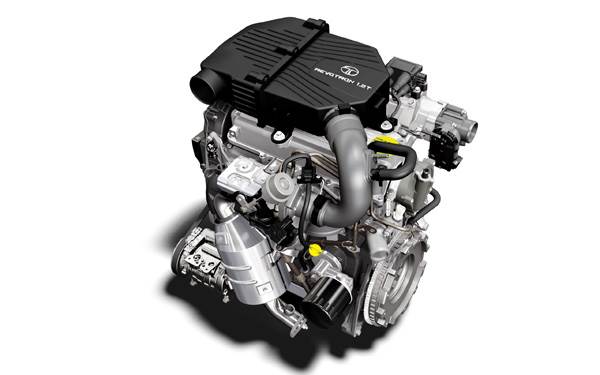Tata Motors has just announced its new petrol engine family, dubbed Revotron, and the first engine to bear this new name – the 1.2T. This 1,193cc, four-cylinder, turbocharged, MPFI engine, Tata claims, is the first indigenously engineered motor of its kind. It uses drive-by-wire technology, features multiple drive modes and has a cast iron block for better refinement.
Now, because of the government provision that allows excise benefits to sub-four-metre cars with engines less than 1200cc in capacity, there are a lot of 1.2-litre petrol engines in the small car segments in India that the new Tata Revotron will have to compete with. So, just how does it stack up, spec for spec, against them?
The number that people first tend to look at is the maximum power figure, and with a turbocharged 83.8bhp on tap, the Revotron is certainly a big step up over the old naturally aspirated, 64bhp, 1.2 Xeta engine from the Tata Indica. This figure even bests the 1.2-litre petrol engines of the Toyota Etios Liva (79bhp), Ford Figo (70bhp), Fiat Punto (67bhp), Nissan Micra, Micra Active and Renault Pulse (75bhp), the three-cylinder VW Polo (74bhp) and the Hyundai Grand i10 (81.8bhp, so only just). But then, the naturally aspirated 1.2-litre engines of the Maruti Swift, Ritz and Dzire (85.8bhp), the Chevrolet Sail (84.8bhp) and the Honda Brio and Amaze (88bhp) produce even more power. The difference lies in how easily this power is accessed, and while the Revotron 1.2T’s power comes in at just 5,000rpm, you have to rev any of the other engines for at least another 1,000rpm before they output their maximum power.
The less noticed but arguably more significant performance figure in the real world is the torque output, and here’s where Tata’s new engine has the others beaten. It produces a meaty 14.3kgm from as low as 1,750rpm to 3,500rpm. The average max torque the naturally aspirated engines on this list produce is about 11kgm, and you have to rev most of them all the way to about 4,000rpm to reach it. However, it’s worth noting that Maruti’s K12 engine, Hyundai’s Kappa2 engine and Honda’s i-VTEC engine all use Variable Valve Timing (VVT), and this does help responsiveness a great deal.
Now, the obvious elephant in the room is the only other 1.2-litre turbocharged petrol engine that powers a compact car in India, and that’s VW’s brilliant 1.2 TSI. This four-cylinder, direct injection engine has the Tata Revotron 1.2T beaten on specification, producing 103bhp at a similar 5,000rpm, and a massive 17.84kgm of torque between 1,500 and 4,100rpm. There’s also Ford’s exceptional 1.0-litre three-cylinder EcoBoost turbo-petrol in the EcoSport, which has an even higher power output.
Ultimately, these are all just numbers, and only a first drive of this engine in its eventual host cars will reveal how successful Tata has been with its first in-house turbo-petrol engine. The price of these cars will also be telling, as all the technology that has gone into making this engine will surely have been costly, and some of this will undoubtedly be passed on to the customer. But then Tata Motors is known for delivering ‘more car per car’, so there’s a good chance the cars that carry the Revotron 1.2T turbo-petrol engine will be priced very competitively.
Tata Revotron 1.2T | 1,193cc, 4 cyl, turbo | 83.8bhp at 5,000rpm | 14.3kgm at 1,750-3,500rpm. |
Tata Xeta 1.2 | 1,193cc, 4 cyl | 64bhp at 5,000rpm | 10.2kgm at 2,600rpm |
Maruti K12 | 1,197cc, 4 cyl, VVT | 85.8bhp at 6,000rpm | 11.6kgm at 4,000rpm |
VW 1.2 TSI | 1,197cc, 4 cyl, direct injection, turbo | 103bhp at 5,000rpm | 17.84kgm at 1,500-4,100rpm. |
VW 1.2 | 1,198cc, 3 cyl | 74bhp at 5,400rpm | 11.2kgm at 3,750rpm |
Hyundai 1.2 Kappa2 | 1,197cc, 4 cyl, VVT | 81.8bhp at 6,000rpm | 11.6kgm at 4,000rpm |
Honda 1.2 i-VTEC | 1,198cc, 4 cyl, VVT | 88bhp at 6,000rpm | 11.1kgm at 4,600rpm |
Toyota 1.2 | 1,197cc, 4 cyl | 79bhp at 5,600rpm | 10.6kgm at 3,100rpm |
Chevrolet 1.2 | 1,199cc, 4 cyl | 84.8bhp at 6,000rpm | 11.5kgm at 5,000rpm |
Fiat 1.2 FIRE | 1,172cc, 4 cyl | 67bhp at 6,000rpm | 9.76kgm at 4,400rpm |
Ford 1.2 Duratec | 1,196cc, 4 cyl | 70bhp at 6,250rpm | 10.4kgm at 4,000rpm |
Nissan 1.2 | 1,198cc, 3 cyl | 75bhp at 6,000rpm | 10.6kgm at 4,000rpm |
Also read >> Tata Motors launches new Revotron petrol engine family



Comments
Member Login
Personal Details
No comments yet. Be the first to comment.